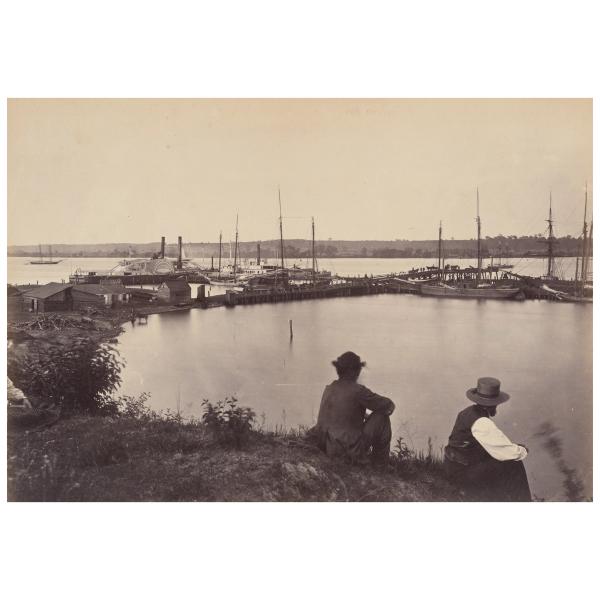Government Coal Wharf, Alexandria, Virginia
Artwork Details
- Title:Government Coal Wharf, Alexandria, Virginia
- Artist:Andrew Joseph Russell (American, 1830–1902)
- Date:1863–65
- Medium:Albumen silver print from glass negative
- Dimensions:Image: 8 15/16 in. × 13 in. (22.7 × 33 cm)
Sheet: 8 15/16 in. × 13 in. (22.7 × 33 cm)
Mount: 13 3/16 in. × 17 11/16 in. (33.5 × 45 cm)
Frame (approx): 18 1/2 x 22 1/2 in. - Classification:Photographs
- Credit Line:Purchase, Vital Projects Fund Inc. Gift, through Joyce and Robert Menschel, 2019
- Object Number:2019.481
- Curatorial Department: Photographs
Audio

610. Mineral Extraction
Government Coal Wharf, Alexandria, Virginia, 1863–65
SIOBHAN ANGUS: In some scenes of extraction, the sort of violence of extraction is made very clear. But in a lot of them, especially in the nineteenth century, they are quite beautiful.
NARRATOR: In this scene, we see coal mined in the Appalachian Mountains arriving by ship in Alexandria, Virginia.
ANGUS: Coal is, of course, a major source of energy, of heat, so it's really essential.
My name is Siobhan Angus, and I’m an assistant professor of media studies at Carleton University.
When we think about coal, in particular coal mining, is brutal, right? It’s a really damaging industry. We think about workers coated in coal dust as a sort of visual signifier of the subjugation of the working class.
NARRATOR: But that’s not what we see here.
ANGUS: The impression of it is actually quite contemplative, right? These two men, looking at the water.
And so I think that that sort of formal tension between how you feel when you look at it and what you know it's about is actually really productive.
NARRATOR: But this image isn’t just about extraction. It’s an object—it’s a product of extraction, too.
ANGUS: So, this is an albumen silver print. Albumen silver prints were the most popular form of photographs in the nineteenth century.
NARRATOR: And as photography became more and more popular, the demand for mined silver grew and grew.
ANGUS: I think that if we put materiality and representation into dialogue, we get a more complicated understanding of what role photography plays in the context of these sort of massive environmental transformations that happen in the nineteenth century and then sort of escalate throughout the twentieth and twenty-first centuries.
NARRATOR: These days, we tend to think of digital photography as dematerialized—as having no physical substance.
ANGUS: And this is actually not true at all. To make technologies sort of smaller, faster, lighter, there’s been a scaling up of mineral intensiveness.
Eighty four percent of the stable elements on the periodic table go into a smartphone or a digital camera. And so many of our geopolitical conflicts right now are also about access to critical minerals, right? It’s incredibly important. So, if we go back to this moment like the Civil War where they’re really trying to secure mineral supply chains, we’re in another moment like that.
More Artwork
Research Resources
The Met provides unparalleled resources for research and welcomes an international community of students and scholars. The Met's Open Access API is where creators and researchers can connect to the The Met collection. Open Access data and public domain images are available for unrestricted commercial and noncommercial use without permission or fee.
To request images under copyright and other restrictions, please use this Image Request form.
Feedback
We continue to research and examine historical and cultural context for objects in The Met collection. If you have comments or questions about this object record, please contact us using the form below. The Museum looks forward to receiving your comments.